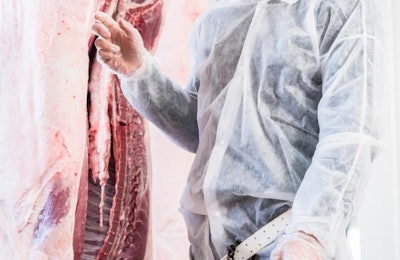
A study of UK pig abattoirs showed that pig meat inspection results can complement veterinary reviews at slaughter and give farmers clues about their living animals’ health. The study’s lead author suggested that using pig meat inspection data can help with early detection of respiratory lesions and other signs of disease. Catching pig lung disease early can reduce farmers’ need for medical antibiotics and lower veterinary costs for living animals.
“Meat inspection is meant to protect human health, but it can work like a massive post-mortem to find pig disease and stop it before getting worse,” Carla Correia-Gomes, PhD, veterinary epidemiologist at Scotland’s Rural College, told Pig International. “Meat inspection may catch those animals that look healthy, but actually have sub-clinical lesions or other health issues.”
Voluntary veterinary inspections
Currently, a voluntary system in the UK allows pig farmers to take their pigs to one of 14 abattoirs where veterinarians inspect the animals. The vet then gives the farmer a detailed report of that pig herd’s health.
That report includes benchmarks to national data so a farmer can compare their performance to others. The system allows farmers to monitor the success of medical treatments at reducing disease symptoms, which guides farmers as they adjust practices with their living herds.
Although the veterinary inspection is not legally required, a meat hygiene inspection is necessary in the UK. The pig’s carcass after slaughter is inspected for threats to human health. UK pig farmers can get those results as well, but the data is less detailed than the vet inspection.
Abattoir study results
In her study, published in the journal PLOS ONE, Correia-Gomes compared data from 322 batches of both meat and pig herd veterinary inspections, and national level data from both systems from 2008 to 2012. She found that when both types of inspectors looked at the same pig carcasses, the two monitoring systems supported each other. Although the meat inspectors didn’t give as many health statistics to farmers as the vets, pig meat inspection did reveal large scale patterns that corresponded with the medical information.
Pig meat inspections could be particularly useful for catching signs of respiratory disease, such as respiratory lesions, Correia-Gomes said. Respiratory lesions are associated with major economic losses from pneumonia, pleurisy and other pig lung diseases. Plus, if a pleurisy-infected animal slips into the abattoir, it requires stopping and cleaning the line, costing abattoirs money.
Support for voluntary vet inspection, not replacement
“Our study’s results don’t support eliminating the voluntary veterinary inspection,” said Correia-Gomes. “Pig farmers and health officials would lose a level of detail.”
Also, the voluntary system shows pork-importing nations that the UK pork industry is taking action against disease, said Correia-Gomes. Denmark pioneered the use of voluntary pig herd veterinary inspections and found that useful information could be collected. Now, Sweden, Norway and Germany use similar systems.


















